President Trump on Monday proposed a record $4.75 trillion budget for fiscal 2020 that calls for steep cuts to domestic spending on programs like health care and education and seeks to further increase spending on the military. The president’s blueprint also includes $8.6 billion for construction of a wall on the border with Mexico, potentially setting up another showdown with Congress over the issue — or even another government shutdown.
Russ Vought, acting director of the White House Office of Management and Budget, said in a statement the proposal “shows that we can return to fiscal sanity without halting our economic resurgence,” but Democrats sharply criticized the blueprint and fiscal watchdogs said it relied on fantasy assumptions.
Here’s a look at some key details:
A major increase in military spending: The president’s budget is the largest in U.S. history, and it calls for spending $56 trillion over the next 10 years. It proposes to raise defense spending to $750 billion — a nearly 5 percent increase from 2019 and even more than the Pentagon had asked for, Foreign Policy notes. But it achieves that increase, and stays within spending caps, by relying on what bipartisan critics decry as an accounting gimmick: shifting some $165 billion in regular defense expenditures to an off-the-books fund for fighting wars. The budget reportedly also proposes to increase spending on Veterans Affairs (up 7.5 percent) the National Nuclear Security Administration (up about 9 percent), the Department of Homeland Security (up more than 7 percent) and NASA (up 1.4 percent).
And big spending cuts elsewhere: The budget proposes a total of $2.7 trillion in spending cuts over the next decade, which the White House says is also more than any administration in history, under Trump’s directive to cut spending by 5 percent across a range of domestic and international programs. The cuts would not be evenly distributed. Axios has a rundown of proposed reductions across various departments, including a roughly 31 percent cut to the Environmental Protection Agency, a 23 percent cut to the State Department, a 21.5 percent cut to the Transportation Department and a 12 percent cut to the Education Department. The cuts in nondefense discretionary programs for 2019 would amount to $100 billion, according to the Times.
Including big changes to health care programs: The budget also proposes to slow spending on Medicare by $845 billion over 10 years relative to the current baseline, in part by curtailing fraud, abuse and payments to hospitals. And it seeks to dramatically overhaul Medicaid, the health care program for low-income Americans, reducing spending by $1.5 trillion. White House officials said the cuts include $1.9 trillion from mandatory safety net programs like Medicaid, The New York Times reports. The budget also proposes new work requirements for food stamps, federal housing support and Medicaid, which the administration says would reduce spending on those programs by $327 billion.






